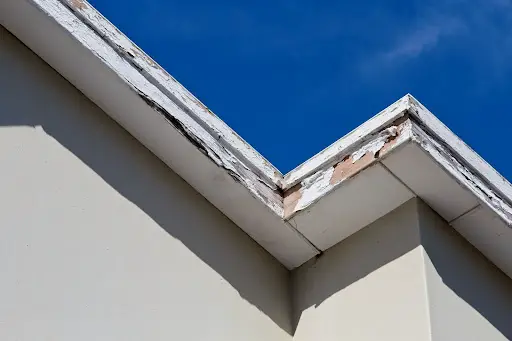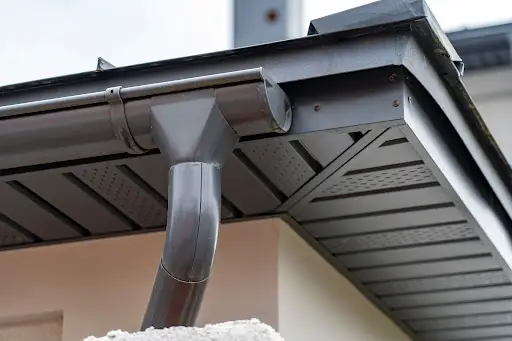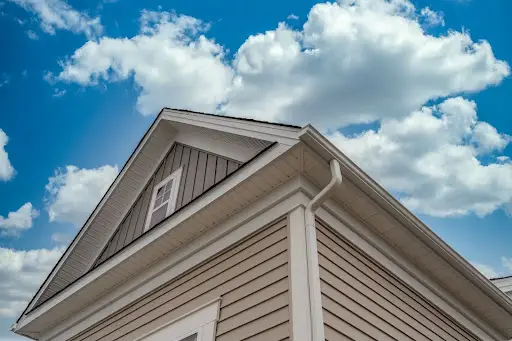What is a Fascia roof?
Several homeowners often choose to restore their gutters when they replace a roof. Some may even opt to either add “capping” to the list or even replacing their soffit and fascia. The long, straight board that runs along the bottom border of the roof is what we call the fascia board. It is often fixed directly to the lower parts of the roof trusses. Apart from the fact that it carries out the task of supporting the lower edge of the bottom row of tiles, the fascia board also handles all the guttering.
The soffit board, on the other hand, exists under the fascia board. Usually tucked away under, it is the board that you recognize most from street level. This board can be ventilated to allow airflow into the roof area. This way, the top of the fascia board gets ventilated too. Without enough ventilation, condensation will arise in the roof void, heightening the risk of timber decay.
That’s why the major benefit for putting these projects together is mainly centered around assuring the water-tight nature of the entire roof line. Your roof, gutters, soffit, and fascia all function together to secure the top of your home. Because of this, replacing all of them simultaneously ensures a lasting project you won’t have to keep doing for years to come.
In this article, we’ll discuss the fascia roof, its purpose, types, importance, its similarities and differences with soffit and some other useful information.
The Purpose of Fascia Roof
You now know that fascias are the horizontal boards that carry a home’s gutters, running the length of any side of the house. While some are made from wood, others are crafted from aluminum. Recent construction, though, often tends to tilt more towards vinyl or some other composite materials for these boards.
In light of all these, below are some of the few things fascia roof exist for:
- Fascia is used to protect the gutters to the roof and keep them steady and grounded.
- It also blocks water from the roof deck and ultimately into the attic/home.
- Fascia is used to heighten curb appeal by covering the open/rough ends of the rafters.
- This roof also seals redundant access to the home by insects, birds, squirrels, etc.
Types Of Roof Fascia
Wood Fascia
Mainly built with timber, wood fascia is the traditional way roof fascia gets constructed. Here, all the eaves projections on the building would get covered with polished timber. Most fascia capping projects also afford the option of replacing your existing fascia with new wooden boards.

In cases in which the fascia board is original to the home or looks to be rotting, new wood is obtained before capping the fascia. This process prevents stress and unnecessary problems as time goes on.
Merits of using Wood Fascia
- It is easy to build and set up.
- It is less costly compared to its other counterparts.
- Few resources are spent on it as it doesn’t require much periodic maintenance.
- It can be used for both low and high pith roof design.
- It can be used for small and large buildings.
Demerits of using Wood Fascia
- When not well constructed, it can lead to leakage.
- Wood is also subjected to rotting because of its water-resistant nature.
- It also has to be primed and painted from time to time to ensure longevity.
Aluminum Fascia
In the case of aluminum fascia, the building edges sometimes get covered with long-span aluminum roof covering. This happens by bringing more roof carcasses to the roof edges and covering it up with an aluminum case.

Advantages of Aluminum Fascia
- It is quite easy to set up.
- It is also less costly.
- Just like wood fascia, there’s little need for periodic maintenance.
- Aluminum fascia can be used for both low and high pith roof design.
- It can be used for small and large buildings.
Demerits of Aluminum Fascia
- It’s prone to leakage when it’s not well-built.
Concrete Fascia
This fascia involves precast concrete with a unique mold constructed around the roof’s perimeter.
Advantages of using Concrete Fascia
- It is more durable than other types of Roof Fascia.
- It’s also more aesthetically pleasing to the building design.
- It has little to no periodic maintenance costs
Demerits of using Concrete Fascia
- It is pretty costly compared to other types.
- There’s also a need for a specialist for its construction.
- When compared with small building costs, it’s not economical.
- Concrete fascia only functions for high-pitch roofs.
Vinyl Fascia
This fascia is commonly known as polyvinyl chloride (PVC). Standard forms of this fascia include plasticizers for more flexibility. It is also included in the wooden fascia to incorporate better appeal and heighten the overall lifespan.

Advantages of using Vinyl Fascia
- It has more curbside appeal.
- When added to the wooden fascia, it also increases the water resistance.
Demerits of using Vinyl Fascia
- It had a shorter lifespan.
Ways to Protect Your Fascia Roof
As you might have inferred, a common problem fascia roofs face is rot. This is significantly associated with wooden fascias. A known cause of this is leaking, blocked, or inefficient gutters. Useless gutters, which might also be old, allow water to build up into the fascia board and destroy the roofing system. That’s where “capping” comes in.
Clogged gutters, animal infestation in an attic area and other roof problems are some of the few reasons anyone might end up with a damaged fascia board. This destroyed fascia board can go on to be the Genesis for other roof issues and in time, spread to damage in an attic and home. This is something anyone would like to experience. So it’s important to replace your fascia if you see it damaged.
In light of all these, below are some other ways to secure your fascia roof:
Timely Roof Inspections
When you develop the habit of taking regular roof inspections, you’ll be able to avoid certain damages before they happen or become worse. These inspections also help you notice little repair needs or things you could include stopping your roof from damage. This way also allows you to evade any financial costs.
Bringing Your Old Fascia Board Up To Date
You could also choose to update your old fascia board before it becomes outdated. Modern roofing options give owners room to wrap their old wooden fascia board with aluminum or vinyl material. As we discussed above, this process can significantly increase the lifespan of your fascia board and secure your home roofing system.
Importance of Fascia Roofs
There’s so much to fascia roofs than just aesthetics or structures. These roofs also protect the house from different natural elements. When incorporated with soffits, they can prevent water, pests, and wind from invading your home. They also render an adequate cover for your attic’s ventilation.
The roof fascia also supports the edge of the bottom row of tiles. Because of gutter installments on the fascia, roof fascia also plays a vital role in holding gutters up.
Soffit and Fascia
These two are collectively known as “trim,” and they share certain similarities and differences. Below are some of them:
Similarities
- They both exist below the roofline and gutters for those who have them.
- They secure the home from water, weather, pests, and other natural elements.
- They can either be “capped” or renewed, based on your needs and the existing material’s condition.
- They are both prone to wood rot if the original material is wood.
Differences
- There’s a vertical structure to a fascia board, and it’s most vivid when you observe the home.
- There’s horizontal laying in the case of the soffit board directly under the fascia board.
- Fascia boards cannot get vented while soffit can.
Fascia Capping & Replacement Options
From exposure to moisture to cracks, animal damage, holes, or even noticing bent fascia boards, there are several reasons you could change your fascia. Sometimes, you can repair a part of your fascia instead of replacing the whole board. In other cases, a fascia board that expresses signs of old age, like bowing and cracking, needs to be replaced, even if it looks like you can salvage or manage it.
In light of this, here are a few options you could consider for capping or replacing your fascia:
Metal Fascia Capping
Every fascia capping projects provide options to renew your existing fascia with durable wooden boards. In cases where your fascia board was built with the home or looked to be falling out or fitting, it’s advisable to install fresh wood before the fascia capping. This way, there won’t be any arising issues along the line.
For those that don’t see any need for them to replace their fascia board, there’s an option of capping it with custom-made metal. This metal will be customized to your current fascia’s shape. That way, the original view, and aura will remain intact.
Merits of metal fascia capping include little to no maintenance and its ability to prevent the wood beneath from getting decayed. There are vast choices of colors to pick from. This way, there’s no need to paint the material after installation.
Composite Fascia Replacement
Unlike metal fascia capping, composite fascia replacement centers more on removing the original wood fascia boards. Here, the whole fascia board will exist in a composite material form. One of the known similarities this option shares with metal capping is the maintenance cost.
Vinyl Soffit Capping
People also refer to this as an optional wood replacement. This option shares a similar impact to metal capping. When you cap your soffit with vinyl, it protects your home from water and wood decay. You should also note without capping your fascia; you can’t cap your soffit.
There are two options when installing vinyl soffit capping. One option is renewing the wood boards, and the other is simply capping them. As we mentioned above, it’s advisable to replace your wood boards if the wood is decaying or feeling weak through wear and tear; this way, your home has a tight seal.
The moment you replace the soffit wood, you can then cap them with vinyl. From solid, alternating vented to vented options, you can make choices according to your home’s roof and ventilation needs.
Composite Soffit Replacement
Just like its fascia counterpart, composite soffit replacement is one of the significant options that doesn’t require any maintenance.
By totally replacing your soffit with composite soffit material, this option is also an effective way to make your soffit better.
Here, removal of the wood soffit boards happens first; then, they are replaced with composite. The composite can be solid or vented, depending on your roof’s needs.
Maintenance and Repair of Fascia Roof
Know that while all these options are feasible ways to maintain your fascia board, it’s important to note that replacing it may not be enough to deal with the damage. That’s why you should also ask your roofers how to find and permanently deal with the root cause of the fascia board damage.
Take leaking boards, for instance. It could widen and begin to expose your fascia to moisture. And if your roofer doesn’t fix this problem, replacing your fascia won’t do anything. You and your roofer could even discuss other potential issues like damage from animal infestations and clogged gutters, to mention a few. You could even ask pest control for help with the animal infestation.
It would help if you also endeavored to pay regular checkups the moment you install your new fascia boards. This upkeep is vital to maintain their condition. From time to time, painted and sealed fascia should get a fresh coat.
Conclusion
We hope this article gives you all you need to know about fascia roofs. You can now tell what fascia roof suits your needs and budget best. You also understand how they work well to achieve a successful roofing system. We also hope you now know the best ways to maintain your fascia roofs and how to utilize them enough to get the most out of their lifespan.
